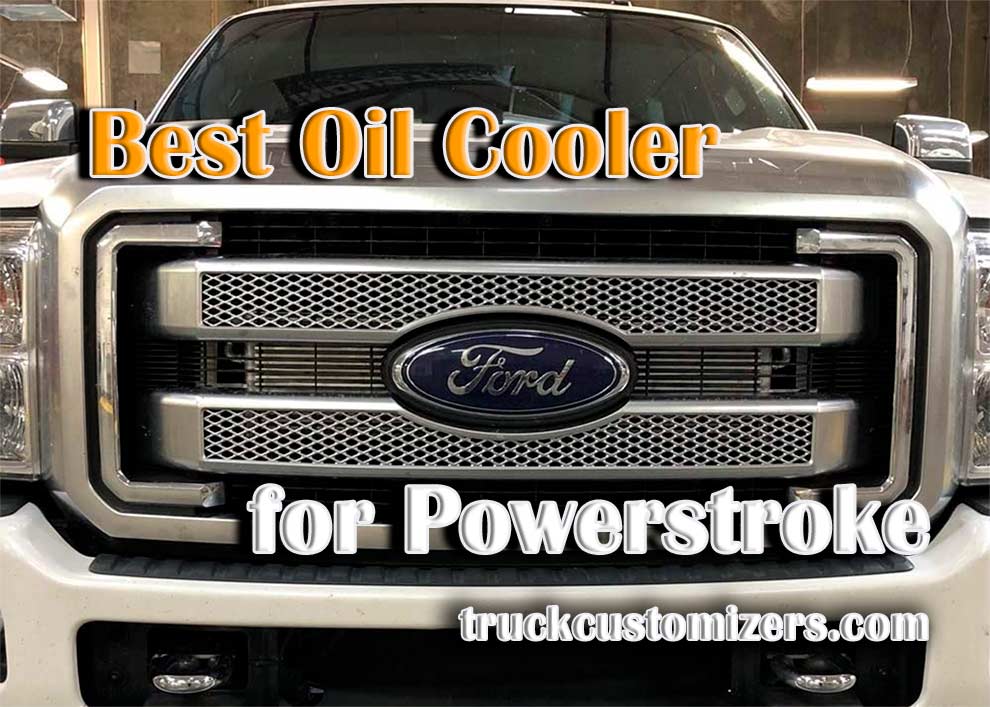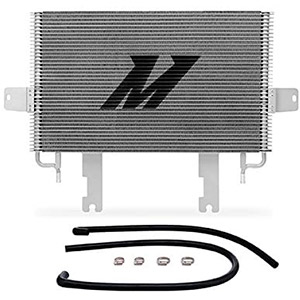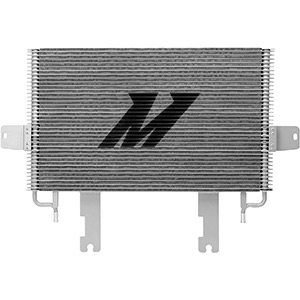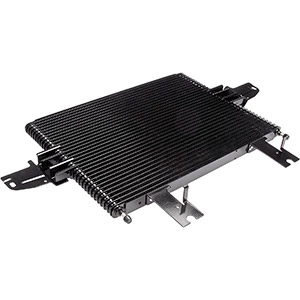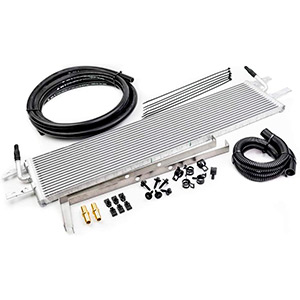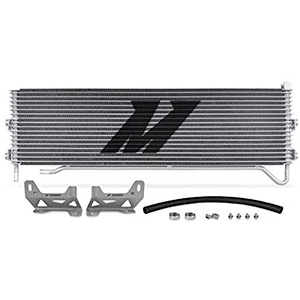Ford’s Powerstroke engines are well-known and respected in the automotive industry. They’re big, strong, and highly reliable in the most challenging situations. On top of that, they are flexible and versatile: you’ve got a choice between six different sizes (from 3.0 up to 7.3). The raw power and extended towing capabilities are what made these motors so popular. However, the cooling system isn’t very great.
This is especially true for the transmission cooler. So, if you want to protect the transmission (and the engine) from premature failure, you might want to swap the restrictive factory gear with the Best Oil Cooler for Powerstroke. Don’t worry: it won’t cost you much. Besides, when installed properly, an aftermarket cooler will serve for a long time. Alright here are the finest offers from leading brands!
Best Oil Cooler for Powerstroke Review
1. Mishimoto MMTC-F2D-99SL – Best Oil Cooler for 7.3 Powerstroke
Let’s start the list with Mishimoto – a prominent player on the market of replacement gear. This particular unit was designed for the 7.3-lit Powerstroke engine and fits it perfectly. With it, you’ll see a significant drop in transmission oil temperature. I’m talking about a 10-degree F/5.6 degree C difference, which is quite a lot. The company’s engineers did a great job of increasing the core volume (it’s 265” larger), ensuring better cooling.
Mishimoto specifically manufactured this cooler for the 1999-2003 Ford vehicles, by the way. So, if you’re, say, driving an older-generation F150 truck, 99SL will be exactly what the doc ordered. The only thing that I didn’t like about this otherwise great unit was the package. It doesn’t come with snap brackets, and the included hoses and clamps are of average-at-best quality.
If you’re in the market for an efficient, reliable, and easy-to-install transmission oil cooler, Mishimoto could very well be the right pick. The extended core volume and market-leading efficiency (-10 degrees compared to stock gear) turn it into a must-have. The only downside is the modest package.
2. Mishimoto MMTC-F2D-03SL – Best Aftermarket Oil Cooler for 6.0 Powerstroke
Next, we’ve got another third-party best 6.0 oil cooler by Mishimoto. These two units have lots in common, actually, because they belong to the same MMTC series. However, there are enough differences between them to make it count. For example, this cooler boasts enhanced fluid capacity (it’s 30% higher than the factory setup). That ensures better (and faster) cooling and less stress for the transmission.
To install 03SL, you won’t need any expensive tools or a mechanic’s help. The whole thing takes 1-1.5 hours and can be done manually. I want to also mention that Mishimoto ships this product in a premium-grade, safe package that prevents potential damage to the oil cooler and the hardware. Unfortunately, despite the excellent packaging, quality control (missing parts, wrong product(s), and slow deliveries) can be a problem.
What can you expect from this MMTC-series transmission oil cooler for the Powerstroke engine? Higher fluid capacity, fast, straightforward installation, and a secure package/box – that’s it for the biggest pros. As for the cons, some customers report issues with quality control and assurance.
3. Dorman 918-216 – Best Automatic Transmission Oil Cooler for 6.0 Powerstroke
When it comes to radiators and oil coolers, material quality plays a key role in reliability, durability, and efficiency. Dorman is crafted from premium-grade, rust-resistant aluminum. So, you can stop worrying about tear/wear, cracks, or corrosion with it. Besides, before hitting the market, this product was put through a series of tough tests to prove its worth. As a result, its pros include extra sturdiness and longevity.
Another standout “feature” is the low price. If you don’t have the budget for the more expensive units at the time, but do need a new cooler, Dorman could be it. The only downside has to do with the installation: while the process is pretty straightforward, it could take 2-3 hours (depending on what kind of truck or SUV you’re driving). Or, if it’s a 100% perfect match, you’ll be done with the replacement in 1-2 hours.
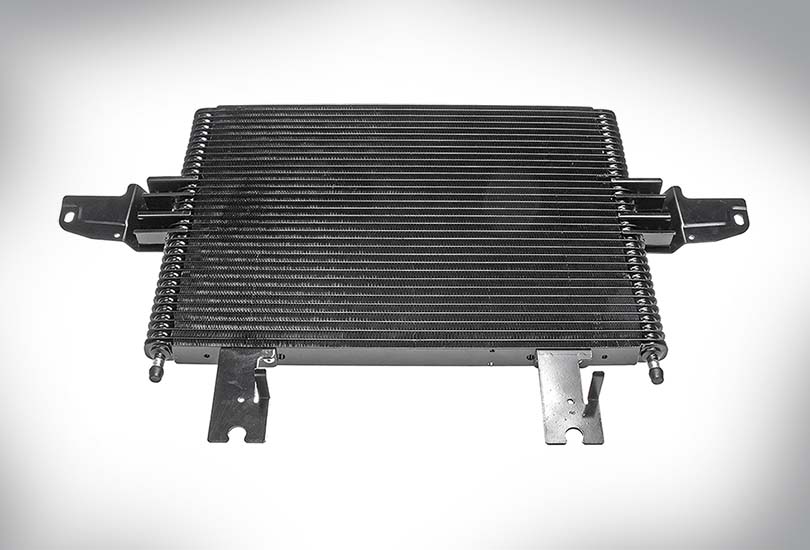
The best way to describe the Dorman oil cooler is “tough”. At the production stage, it easily completes the most demanding durability tests. In addition, it is engineered from aluminum (heat- and rust-resistant). The installation might be a bit tricky, but that’s compensated for by the low cost.
4. Driven Diesel – Best Transmission Cooler for 2016 Ford 6.7 Powerstroke
Moving on with the list, we’ve got Driven Diesel, one of the finest aftermarket transmission oil coolers for the latest-gen Ford vehicles. If you’ve got a rough-tough truck with the mighty 6.7-lit Powerstroke, this cooler will fit it like a glove. Speaking of fitment, the package includes top-notch hardware for installation. You won’t have to buy any extra nuts, bolts, or hoses – it’s all a part of the deal.
Driven Diesel is engineered from construction-grade stainless steel: T-304. It’s almost as good as aluminum and is quite effective at dispersing heat and keeping the temperature low. Designed, tested, and manufactured in the States, this oil cooler will be the right pick for most Ford owners. Do remember, though, that it’s not particularly cheap and will cost you a bit extra.
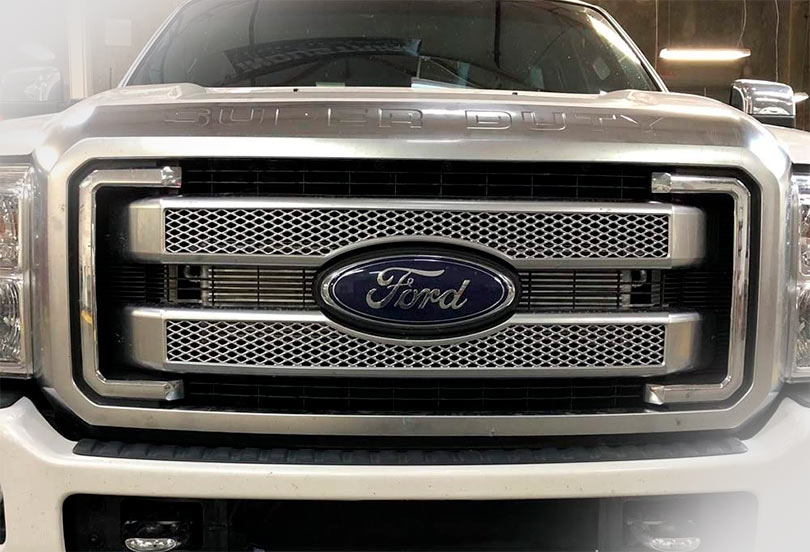
Engineered in the US, packed with top-of-the-line installation hardware, and built from T-304 steel – that’s the Driven Diesel transmission cooler in a nutshell for you. It’s a bit on the expensive side but will be worth the investment if you’re in the market for a premium-quality product.
5. Mishimoto MMTC-F2D-08SL – Best Transmission Cooler for 6.4 Powerstroke
One of the worst things that can happen to a radiator or cooler is cracks and leaks. The reason – you’ll get immediate side effects like lackluster performance, slow starts, and poor fuel efficiency, among other things. Thankfully, that won’t be an issue with Mishimoto’s 08SL, because it is well-protected against wear and tear. On top of that, it features the so-called stacked-plate design which makes it even stronger.
Add adjustable brackets that allow the driver to fit the cooler with larger-than-average radiators, and you’ll see why this unit deserves a spot on the list. There is one downside, however: while Mishimoto is, of course, more effective and efficient compared to the factory gear, you won’t see any mind-blowing gains. Again, it will be better, but not by a landslide.
Easy to install/fit with other cooling gear and highly resistant to cracks and leaks, the 08SL transmission oil cooler by Mishimoto is a sure pick. It also features an advanced, robust design. Just don’t expect any ground-breaking improvements over the standard Powerstroke system.
How to choose the best Oil Cooler for 6.0 Powerstroke?
Let me guess: you want to find the best bang for your buck, but seem a bit lost when there are so many different coolers available? Don’t worry: I’ve got your back! Here are the key factors to keep in mind before making an order:
-
Compatibility + Fitment. The cooler must fit your vehicle easily. Otherwise, you’ll spend lots of time, money, and nerves trying to make it work. Look in the specifications: the manufacturer will specify which vehicles (or, rather, engines) are officially supported.
-
Build + Material Quality. This is another important aspect to check. In most cases, you’ll be choosing between steel (409 or 304) and aluminum. Well, as we learned from the reviews, aluminum is a superior option, but it’s slightly pricier. With steel, you’ll still get decent anti-rust protection and heat resistance, of course.
-
The Brand. Should you trust big brands when scrolling through different transmission oil coolers? The answer is yes, you mostly should. While a well-established and respected manufacturer doesn’t always mean it will deliver the best bang for your buck, still, if you’re choosing between two similar options, I would recommend going with a famous brand.
On the other hand, once you go through this post and learn your way around oil coolers, you’ll be able to make an educated choice and pay less attention to the brand. So, don’t forget to check out the Buyer’s Guide further down the review for even more key points to consider before making a decision.
Are Transmission Oil Coolers worth it?
Yes, they most definitely are if you want your Powerstroke-equipped truck to run smoothly and have a long lifespan. As the name suggests, these accessories have only one job – to keep the transmission fluid cool. However, they have a positive effect on the entire powertrain and help avoid hefty repair checks. I want to stress that to fix an overheated gearbox, you’ll have to pay quite a lot (and even more if the engine breaks down).
Therefore, unless you’re one of those folks that buy expensive vehicles with powerful motors only to stick to “civilized” roads, an oil cooler is, in many ways, a must-have. Surprisingly enough, most Ford trucks and SUVs have rather mediocre cooling gear (including the radiator, the oil cooler, and the water pump). So, if you’ve got a budget for aftermarket upgrades, I would very much suggest you start with the cooling system.
Does a Transmission Cooler add Horsepower?
The short answer – no, it doesn’t really do much to boost the HP output. You shouldn’t expect any significant gains in torque or acceleration either. Remember: the main purpose of any cooling system is to keep the fluid from overheating (or going beyond a set temperature limit). In contrast to an exhaust system or a cold air intake kit, “coolers” don’t provide any powertrain gains.
You might see minor improvements in the throttle response or an extra HP or two, but, again, the increase will be very subtle for the vast majority of truckers. Obviously, if the factory cooler was defective, an aftermarket replacement will make a dramatic difference (in a good way), as you won’t experience any trouble with the gearbox. I’m talking about late shifting, inconsistent performance – things like that.
Does a Transmission Cooler Extend the Life of a Transmission?
Yes, it most certainly does, because there’s no such thing as transmission fluid that’s too cool. Even if you’re driving at a slow pace and don’t do lots of off-roading, depending on the rest of the gear (especially the engine and the transmission) and the climate, the gearbox will still be in some sort of stress. Thus, you will substantially extend the life cycle of the transmission no matter how much pressure you put on it.
Now, you should never just buy the first cooler you see. There are lots of different options on the market, and for the best results, I recommend getting your hands on a larger-than-average unit. Do make sure that it’s compatible with your truck and will fit in the mounting spot. We’ll talk about the importance of the surface area, cooling cores, and capacity in more detail in the Buyer’s Guide.
Right now, I want to say once again that a transmission oil cooler should be on your priority upgrades list. When taken care of properly, it will go on for many years, if not decades. And, by keeping the fluid cool and the gearbox in prime condition, a cooler will also allow the truck to work harder without any breakdowns.
How do I know if my Oil Cooler is Bad on my 6.0 Powerstroke?
First of all, make a habit of constantly checking not only the oil cooler but the entire cooling system. That way, you’ll be one step ahead and be able to predict or even prevent transmission failure. On top of that, here’s a list of common signs and symptoms of a faulty cooler. If you experience any of these side effects, most likely, you’re dealing with a bad oil cooler:
-
This is the most common sign that the cooler is in dire need of a replacement. I just mentioned that these accessories have quite an impressive lifespan, and that’s still very much true. However, if it’s too humid in your area, that can lead to corrosion. Wear/tear is also an issue. So, keep your eyes open for any fluid dripping from the truck, and if it’s not the radiator, or anything else, that leaves the cooler to blame.
-
High temps. When the cooler fails to do its job, the transmission fluid gets dangerously hot. And when that happens, a warning sign will pop up on the dashboard. If you see it, stop the truck right away and check on the fluid levels. I would recommend inspecting the engine coolant as well. Sometimes, the Check Engine light appears instead of the transmission icon; but, that happens rather rarely.
Why is it Important to Replace the Oil Cooler?
It’s really simple: the factory cooling systems in most Powerstroke vehicles leave a lot to be desired. Besides, even if they are up to the task, oil coolers do wear out over time. They tend to get rusty and develop cracks. Besides: if you’re not just a regular driver, but use your truck for towing, hauling, and cargo shipment, a replacement cooler will actually be necessary.
The reason: the more extra weight you carry, and the tougher the terrain, the higher pressure that will put on the transmission. And, without a proper unit with dozens of rows to keep the fluid cool, it will overheat before long, causing the vehicle to break down in the middle of nowhere. Off-roading trails can be quite hard to overcome for a truck with stock gear – keep that in mind.
That’s one of the main reasons why it’s important to take proper care of the cooler and replace it with an aftermarket option as soon as possible. The same is true for high-performance and race cars, by the way. If you know you’ll be pushing the powertrain to the limit, you gotta think about upgrading the cooling system. Otherwise, you’ll end up ruining expensive gear and causing yourself one big headache.
Where is an Oil Cooling Kit Located in the Car?
An oil cooler looks and operates much like a radiator. And, you can find it right in front or behind the car’s AC condenser. This is done to achieve maximum airflow. Another reason for that is to place the cooler in a spot that’s (relatively) cold. Therefore, if you have problems with the transmission fluid and the coolant, or any other issues with the cooling system, just pop the hood, locate the radiator, and you’ll see all the components/accessories there.
Depending on your vehicle (how old or new it is), the actual location of the cooling kit might differ a bit, but it will still be roughly in the same place. In some cases, the cooler sits right inside of the radiator; for rough-tough SUVs and trucks, that has proven to be a better spot for it. Now, if you’re looking to replace the cooler, you won’t have to pay a mechanic to do that for you. The process is pretty straightforward and takes +/- an hour at a moderate pace.
Is a 6.0 Powerstroke Oil Cooler Expensive?
No, you won’t have to break your bank to afford a cooler for the 6.0-lit Powerstroke. But still, how much should you pay for the cooler? And what can you expect to get for different price tags? Right now, entry-level units cost $180-200. And by saying “entry-level”, I mean they’ll perform better than the factory gear. You’ll get more rows, a higher surface area, and lower temperatures, along with added reliability in tough situations.
If you want higher material/build quality, that’ll cost you 300-350 bucks. For most drivers, it’s the “sweet spot”, as you’ll get a great balance of price and quality. For $350-400, Powerstroke-run truck owners will be compensated with a warranty (most likely, a limited manufacturer warranty), quick delivery, and stronger all-around performance.
Fast, client-oriented customer support might be a part of the deal as well, especially if it’s a large-scale brand with a strong presence in the US market. A quick note: transmission oil coolers cost roughly the same as radiators and offer similar perks for extra bucks. Moreover, for 300-400 dollars, you can buy a decent air intake kit, exhaust system, or even tire set.
Buyer’s Guide
In the FAQ, we talked about pricing, fitment, and engineering quality as some of the most important aspects that can “make it or break it” for an oil cooler. And in this guide, I want to introduce you to the “technical” side of things. We’ll discuss real-world cooling efficiency, the importance of core volume, capacity, and also the package. Ready to master the art of picking the perfect unit for your Powerstroke? Let’s get to it!
#1: Efficiency/Temperature Drop
Unless you’re a pro mechanic or someone who knows their way around cars, you’re probably wondering: why do I need a replacement transmission oil cooler? Isn’t the factory gear enough? Well, sometimes, it isn’t, especially if you drive a big, “hungry” truck (say, an F250 or an F350). And that’s why efficiency should be the #1 thing to check before making any orders.
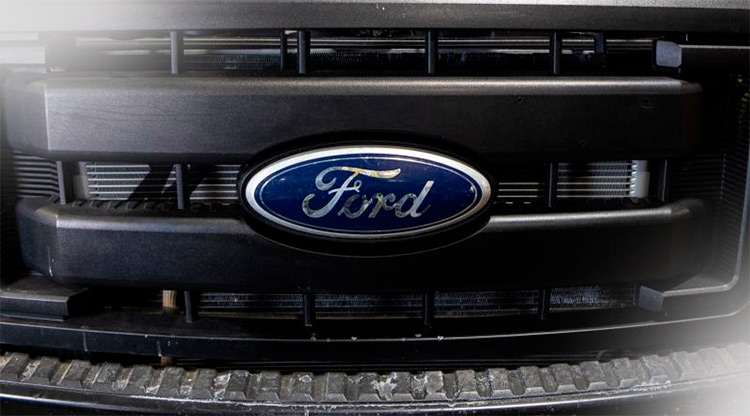
A premium-quality third-party cooler will be able to drop the transmission fluid temperature by 10 degrees Fahrenheit (5.6 degrees Celsius), and that does make a pretty big difference. A unit like that won’t be cheap, of course, but there are lots of more affordable options that reduce the temps by 5-8 degrees, which is also a decent enough improvement.
#2: Core Volume: the More, the Better
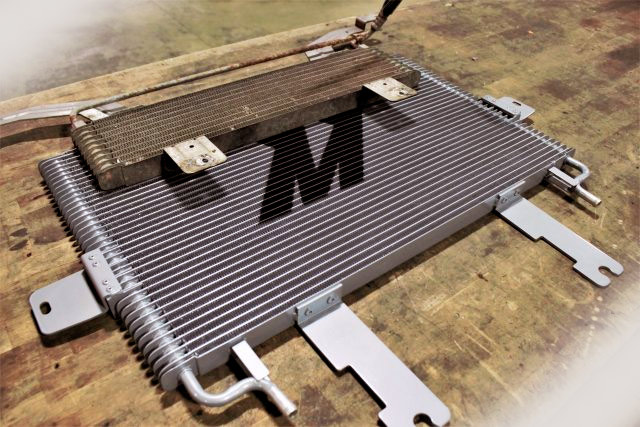 How does an aftermarket cooler “beat” the stock system? By increasing the core volume and the surface area, of course. Now, older-generation Powerstroke-run motors only have 9-row coolers; the newer trucks pack 20-31. Keep this in mind and always compare the number of rows of the factory cooler to that of the replacement unit. The rule of thumb here is the more, the merrier, as extra rows ensure better cooling.
How does an aftermarket cooler “beat” the stock system? By increasing the core volume and the surface area, of course. Now, older-generation Powerstroke-run motors only have 9-row coolers; the newer trucks pack 20-31. Keep this in mind and always compare the number of rows of the factory cooler to that of the replacement unit. The rule of thumb here is the more, the merrier, as extra rows ensure better cooling.
As we learned earlier from the FAQ, when the transmission fluid isn’t properly cooled down, that leads to overheating and all kinds of severe consequences. That’s why you should never rush when scrolling through the available oil coolers and pay extra attention to how many cores it has and how large the surface/active area is.
#3: Fluid Capacity Comes Next
And let’s not forget about capacity. This is another important parameter/factor to consider. As the name suggests, it indicates how much transmission oil slash fluid the cooler can hold. Without getting into complex details, let me just say that higher fluid volumes equal better cooling. This is true not only for the transmission oil cooler, but also for the radiator, by the way, and any other cooling system.
Now, if it says in the specs that the cooler increases fluid capacity by 1/3 qt. over factory gear, I’d say put it on the list. And if you’ve got extra bucks to spare, look for a unit that boosts volume/capacity by 1.0 quart. With gear like that, you’ll see instant (and pretty big) improvements in oil temperature.
#4: The Package/Hardware
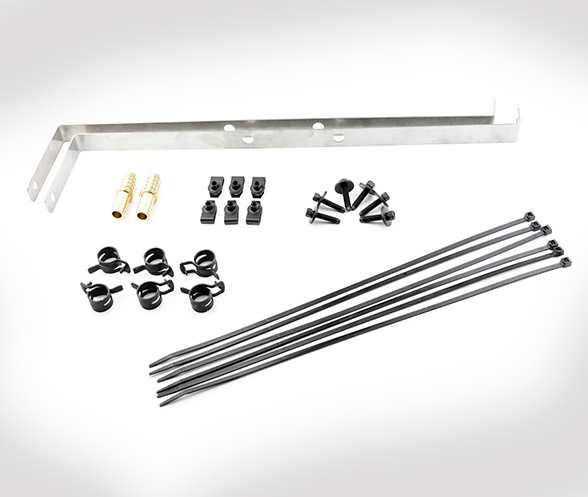 So, you found a third-party cooler with a large surface area, extended fluid capacity, and significantly better performance than the limited stock gear. But wait – don’t hit “order” just yet. There’s one last thing to check – the package. And no, I’m not talking about the warranty, because we mentioned that earlier. The focus here is on the hardware. Does the cooler come packed with everything necessary for the installation, or not?
So, you found a third-party cooler with a large surface area, extended fluid capacity, and significantly better performance than the limited stock gear. But wait – don’t hit “order” just yet. There’s one last thing to check – the package. And no, I’m not talking about the warranty, because we mentioned that earlier. The focus here is on the hardware. Does the cooler come packed with everything necessary for the installation, or not?
All the nuts, bolts, clamps, washers, and hoses aren’t that cheap if you buy them separately. Besides, you’ll have to wait for the hardware to arrive, which is inconvenient at the very least. An installation manual would also come in handy. The actual package matters as well: ideally, it should be reinforced and secured for shipment. It’s not rare for packages to arrive all dented and bruised.
Conclusion
Statistically, most modern-day drivers are only concerned with keeping the engine cool and invest in aftermarket radiators and premium coolant products. However, the transmission is just an important part of the powertrain, and you need to keep its fluid/oil cool as well. Today, we checked out five top-of-the-line oil coolers for the Powerstroke engine. Rigorously tested, they’ve all passed the toughest tests and can be relied upon.
If you’re on a limited budget and need an affordable cooler, take a closer look at Dorman – it’s available at a low price. The Driven Diesel unit, in turn, is quite expensive but does have a long list of pros. With Mishimoto 99SL, you’ll get strong performance. The other two units are also worth your attention. Yes, there’s plenty to pick from. So, choose wisely!
